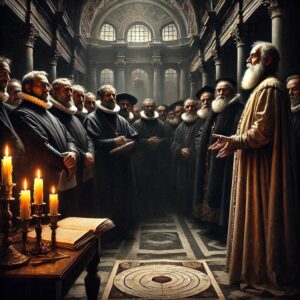In February 1633, the brilliant astronomer Galileo Galilei arrived in Rome to face the Roman Catholic Inquisition. His crime? Supporting the radical idea that the Earth revolved around the Sun. At the time, this heliocentric theory, originally proposed by Copernicus, directly contradicted the Church’s long-held belief in a geocentric universe. What should have been a triumph of scientific discovery instead became one of the most infamous trials in history, highlighting the dangerous clash between faith and reason.
Galileo had spent years observing the heavens with his telescope, gathering evidence that supported the heliocentric model. His discoveries, including the moons of Jupiter and the phases of Venus, provided undeniable proof that Earth was not the center of the universe. However, the Church saw his work as a direct challenge to biblical scripture and its authority. In 1616, he had been warned to abandon his teachings, but his 1632 publication, Dialogue Concerning the Two Chief World Systems, reignited the controversy. The book’s arguments were too compelling—and too dangerous—for the Church to ignore.
Summoned to Rome, Galileo faced a grueling inquisition. Under the threat of torture, the 70-year-old scientist was forced to recant his findings. Legend has it that after his confession, he muttered, “E pur si muove”—”And yet it moves”—a defiant whisper affirming the truth of his discoveries. Though he was spared execution, Galileo spent the rest of his life under house arrest, his groundbreaking work stifled by religious authority.
Galileo’s trial was a defining moment in history, symbolizing the struggle between scientific progress and institutional dogma. Despite his persecution, his ideas endured, eventually leading to the widespread acceptance of the heliocentric model. Today, he is celebrated as a pioneer of modern science, a man who dared to challenge the status quo in pursuit of truth. His legacy reminds us of the importance of free thought and the relentless pursuit of knowledge.

